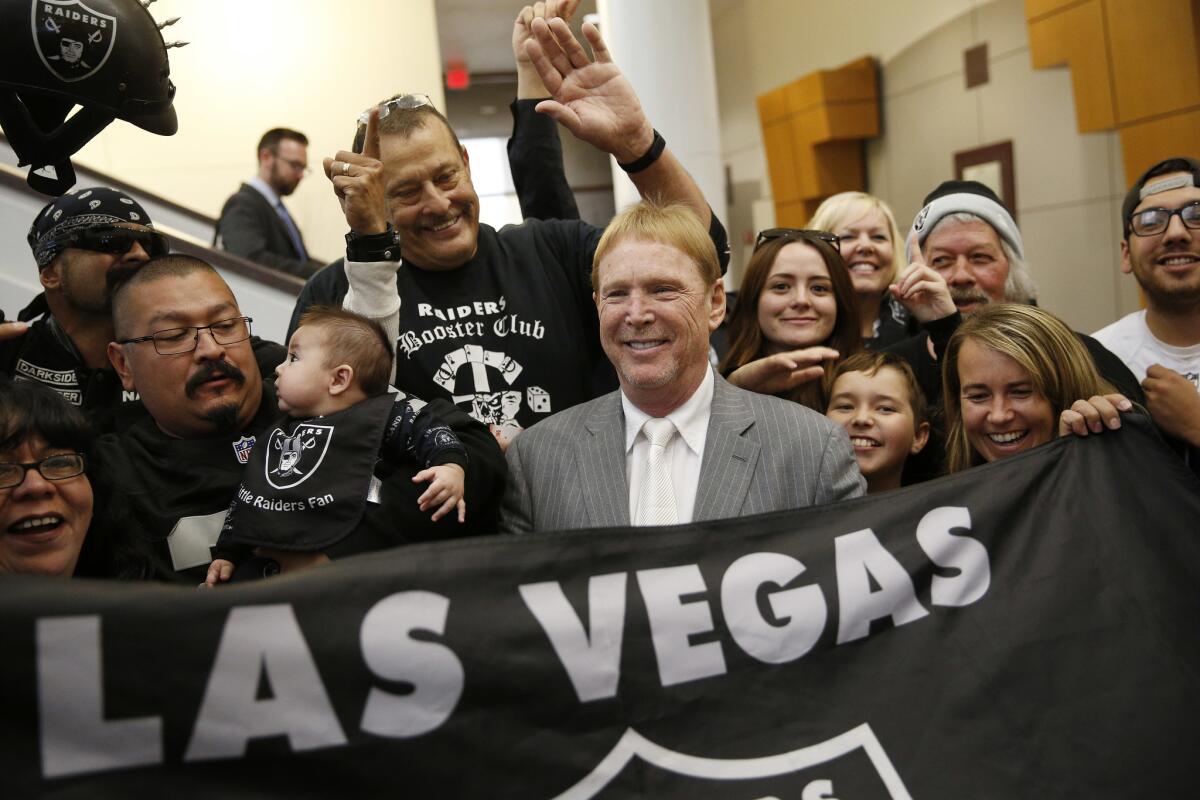Once unimaginable, Las Vegas is finally ready to bet big on the NFL

Union workers clad in jeans and T-shirts mixed with the men in crisp, dark suits. Some held smartphones at arm’s length to capture the big moment. The William Trent Lounge at the University of Nevada, Las Vegas — with its dark wood-paneled ceiling squares, red accent walls and a vacant bar area — was almost hushed.
Then, like a quarterback quieting the home crowd before the snap, Oakland Raiders owner Mark Davis stepped forward, and the last stray voices melted into the silence.
His subject: making Sin City the next home of the Silver and Black.
“It was after the senate vote came through,” Davis said to the rapt group of about 40 people. “I checked in with the governor and said, ‘Just win, baby!’ And he said, ‘Hey, wait a minute. It’s only half-time.’ ”
Once unimaginable in a town where the bloodlines so distinctly run to the gambling halls and sports betting rooms, Las Vegas is steadily gaining yardage in its bid to become one of America’s NFL cities.
After state legislators gave him the needed two-thirds vote, Gov. Brian Sandoval this month signed legislation to raise the hotel bed tax in Clark County to help fund a $1.9-billion football stadium and convention center in hopes of bringing the Raiders from the Bay Area to Las Vegas.
Now, approval is needed from three-quarters of the NFL owners to allow a Raiders relocation, which is being backed by Las Vegas Sands Corp. President and CEO Sheldon Adelson, one of the nation’s wealthiest businessmen.
Like any bet in this town, it still could all fall apart.
But simply paving the path for the biggest professional league in America to come to Las Vegas is one more step in the city’s ambition to shed its image as primarily a gambling mecca — a journey decades in the making with key pivot points along the way.
There was Jerry Tarkanian’s highly successful UNLV basketball teams in the ’80s and ’90s that led to the building of the Thomas & Mack Center; the transformation of the Strip from gambling destination to a place focused more toward conventions, high-end dining, concerts and shows; the removal of the ban on betting on Nevada-based college sports teams and the announced arrival of a professional hockey team set to hit the ice next year.
“It is about the normalization and the mainstreaming of Vegas,” said Andy Abboud, the senior vice president of government relations and community development for the Sands Corp. “Gambling is no longer a novelty, and it’s not unique.”
That larger undercurrent has been swelling since 1996, when only six states had land-based casinos. Now there are 18 states with casinos and 30 that offer some form of gambling.
Bo Bernhard, executive director of the UNLV International Gaming Institute, said the growing global gambling market over the years has shown how sports betting can co-exist with sports teams. He said Australia does it with rugby. England does it with soccer.
“It’s not like Vegas is a one-of-a-kind environment globally anymore,” Bernhard said. “This is something that exists with sports teams and leagues all over the world.”
Las Vegas has always been an epicenter for big, one-time events. Muhammad Ali beating Floyd Patterson, Evander Holyfield beating Mike Tyson and Evel Knievel’s Caesars Palace fountain jump all brought big crowds.
But it wasn’t until Tarkanian arrived at UNLV that a Vegas-based team proved it could draw and hang onto a local fan base.
Danny Tarkanian, who played for his dad as a guard, remembered that once the team began winning regularly, the Thomas and Mack Center was built in 1983.
The $30-million arena, in that first season, sold out when Georgetown — led by Patrick Ewing — came to Vegas, beating the host team by two points. Tarkanian said the crowd had been given white towels, like the ones his father famously chewed nervously from the bench.
“We had never played in front of a sell-out crowd of that magnitude in Las Vegas,” Tarkanian said. “It was an incredibly exciting environment — unlike any I’d been in before.”
The Runnin’ Rebels won the national championship in 1990, and the Thomas and Mack Center, by then drawing celebrities to watch games, began hosting exhibition NBA games.
But when a photo of convicted sports fixer Richard Perry sitting in a hot tub with several prominent UNLV players was published in the Las Vegas Review Journal in 1991, it brought the high-flying team unwanted attention. It wasn’t until a decade later, when Sandoval — then chairman of the powerful Nevada Gaming Commission — oversaw the removal of banning bets on UNLV games that gambling and Nevada-based sports teams began to co-exist.
“I think it really sent a message that we regulate gaming and sports betting better than any other entity on the planet,” Sandoval said.
Luring an NFL team like the Raiders would have been difficult, if not impossible, without that change, said Bernhard of the International Gaming Institute.
The bill signed by Sandoval for the stadium clears the way for $750 million in bonds to build the 65,000-seat domed stadium and convention center. The Adelson family is kicking in $650 million, and Davis is adding $500 million.
Some critics worry Las Vegas will have difficulty filling the stadium with Raiders fans — especially if the economy sours like it did in 2008, when Clark County was buffeted by foreclosures and unemployment. They also cite competition from the Strip, which is a regular stopping point for A-list concerts, and the city’s service-based economy, where the labor force works odd hours, making it difficult for many to attend games.
If the Raiders move, it would be their third home after toggling between Oakland and Los Angeles.
Eric Carrillo, a 42-year-old who moved from Carson to Las Vegas 10 years ago and works as a postal carrier, said the Raiders have a fan base that would be strong locally and would travel from Los Angeles.
After taking a selfie with Davis in his spiked silver-and-black motorcycle helmet, Carrillo said he would try to attend three or four games a year.
Davis said Vegas — which has a population of more than 623,000 — has enough people to support the team, though critics worry about the small television market and some reports of declining attendance at NFL games.
“I think it’s located where everyone can come in,” said Davis, who remains optimistic. “And our fans travel tremendously.”
NHL Deputy Commissioner Bill Daly was convinced the area would have a strong local fan base when it was announced this year that a yet-unnamed hockey team would play in Las Vegas next year. The team already has sold more than 15,000 season tickets for home games at the newly built T-Mobile Arena.
“You can’t plan on tourists to support the club,” Daly said. “There has to be grass-roots support for a professional franchise. There’s more to Vegas than the Strip and a larger, local population beyond it.”
Bernhard said Las Vegas has seen an enormous change in the past 25 years. Casinos have been built and razed. Leagues like the United Football League and the XFL that had Vegas-based teams have come and disappeared.
He said it’s hard to imagine what the city’s identity will be 25 years from now — with or without an NFL team.
“Look at an aerial photo from 1989,” he said. “There’s virtually nothing on the Strip that’s there now. Twenty-five years anywhere in America is a long time. In Las Vegas, it’s a really long time.”
ALSO
Here’s why you may not get free drinks in Las Vegas anymore
Cowboys owner Jerry Jones’ powerful voice is supportive of Raiders’ move to Las Vegas
Las Vegas casinos love Chinese gamblers. So these guys built a casino just for them
More to Read
Start your day right
Sign up for Essential California for news, features and recommendations from the L.A. Times and beyond in your inbox six days a week.
You may occasionally receive promotional content from the Los Angeles Times.







